
A downy white fungal growth, powdery mildew attacks a wide variety of trees and shrubs as well as ornamental plants, indoors or out. Although any tree can get this common disease, the ones that are most commonly affected are oak, maple, dogwood, magnolia, catalpa, and crabapple. Powdery mildew consists of millions of tiny fungal spores that can be spread by the wind to other parts of a tree and on to new hosts. Although the fungus loves humidity and moisture, it can grow on both dry and damp leaves.
Powdery Mildew Signs and Symptoms
Appearing as white or grayish powder-like patches on the surface of leaves and stems, powdery mildew develops mostly on newer growths. Although the fungal spores often look like someone sprinkled baby powder on foliage, the disease can also appear as blotchy, felt-like mats or cobweb-like formations.
Disease symptoms increase when cooler weather is paired with high humidity, and these signs occur more frequently on areas of a tree that are shaded and lack good air flow. As this mildew spreads, leaves begin to yellow and wilt, and eventually, the entire branch dies. Advanced symptoms of an infection also include distorted leaves, premature leaf drop, blemishes on fruit, and buds that won’t open.
Preventing and Treating Powdery Mildew
There are many varieties of powdery mildew, but prevention and treatment methods are very similar.
To prevent conditions in which powdery mildew can thrive, don’t plant trees in extremely shaded areas. Opt for locations with good air flow, sunlight, and plenty of growing room. If necessary, prune trees to provide better air circulation.
Proper sanitation is important to reduce the spread of infection. Immediately remove and dispose of infected leaves or branches that have dropped. Don’t use them for composting or mulching. And be sure to clean and disinfect tools after pruning before you use them again.
Fungicides can be used to control infestations, though many cases of powdery mildew do not require this drastic measure. Because the mildew spreads rapidly, fungicides must be applied at the first sign of the disease’s symptoms. Be sure to prune out severely infected branches first. Sulfur can be used as a spray or dust, but can cause other kinds of damage to the foliage—especially in high temperatures–if not applied carefully.
If you need assistance identifying, treating, and preventing powdery mildew and other tree diseases, contact O’Reilly Tree Experts at 508-339-TREE(8733).
Need Help with Powdery Mildew?
Call O’Reilly Tree Experts today at 508-339-TREE(8733) and let’s talk about how we can help you with Powdery Mildew and other Massachusetts tree diseases.
